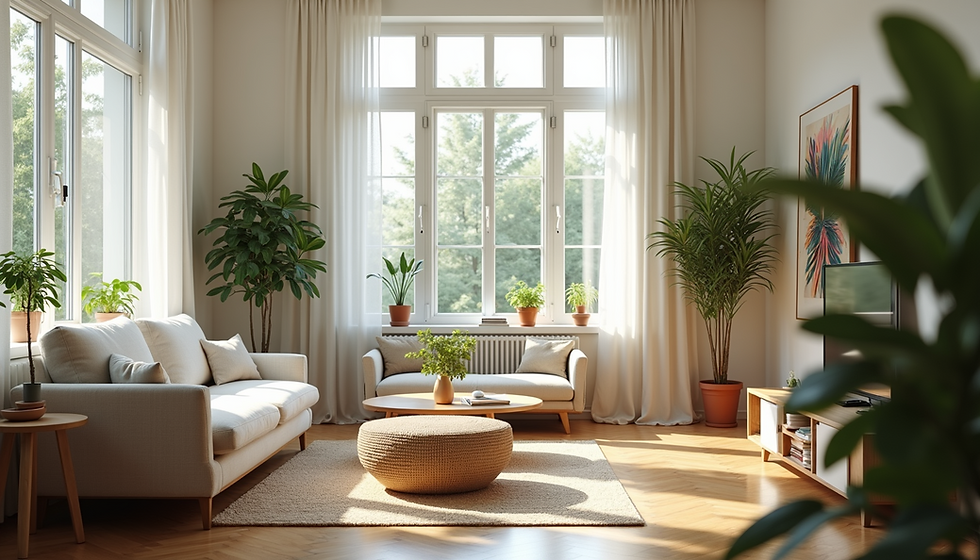The Fusion of Art and Function in Modern Spaces
- Param J Singh
- Jun 9
- 4 min read
In today's world, the exterior and interior environments we inhabit have become a canvas for creativity. The fusion of art and function in modern spaces has transcended traditional designs, allowing for a more harmonious relationship between aesthetics and utility. This blog post delves into how art elevates architectural design, transforming spaces while enhancing their functionality.
The Essence of Architectural Design
Architectural design is more than just constructing buildings; it’s about creating environments that speak to the users. The key elements involve integrating structural integrity with artistic expression.
When we think about the architectural wonders of recent years, structures like the Sydney Opera House in Australia come to mind. Designed by Jørn Utzon, it exemplifies how sculptural forms can serve practical purposes, such as housing performances while boasting a unique aesthetic.
Statistics reveal that buildings that take an artistic approach often see increased engagement. According to a study by the American Institute of Architects, well-designed environments can boost productivity by up to 20%. This proves that investing in artistic architectural design not only beautifies a space but also enhances performance.
Enhancing Functionality Through Art
Many designers are now thinking outside the box. They incorporate artistic elements that serve essential purposes. For example, consider blinds used not just for privacy but also as stunning art pieces.

Sustainable design is also a growing trend that merges art and function. Green roofs in urban environments not only serve an ecological purpose by providing insulation and absorbing rainwater, but they also promote visual beauty. Studies have shown that rooftop gardens can reduce urban heat by up to 10 degrees Fahrenheit, making them essential for climate-controlled architecture.
The Role of Color and Texture in Spaces
Color and texture play pivotal roles in transforming mundane spaces into captivating experiences. The strategic use of bright colors can energize a room, while natural tones can induce calm.
Incorporating textured materials adds depth to a space. For example, reclaimed wood walls bring warmth and character while serving as sustainable options. This approach has been supported by a survey from the National Kitchen & Bath Association, which states that 67% of homeowners prefer textured surfaces, indicating a desire for spaces that feel personalized and unique.

Moreover, the interplay between color and lighting can influence how we feel in a space. Natural light enhances colors, while artificial lighting can alter perceptions significantly. Thoughtful color selection, therefore, not only beautifies but also invites comfort and promotes well-being.
Open Spaces: Merging Functionality and Art
Open floor plans have revolutionized how we perceive space. They offer flexibility, which encourages creativity in design. Areas that previously served single functions can now be multifunctional, demonstrating the importance of artistic elements in everyday living.
In such spaces, art installations can serve as focal points that draw the eye and create conversation. For instance, a large-scale painting or sculpture can transform a living room into a gallery-like ambiance, making the home feel both stylish and welcoming.
This concept is exemplified in many modern homes that feature sliding partition walls. These walls can be adorned with artistic renderings, allowing homeowners to switch between open and closed spaces depending on their needs, effectively merging the artistic with the practical.

The Cultural Impact on Architectural Art
Architectural styles often reflect cultural influences. As global connectivity increases, architects and designers take inspiration from diverse cultures, leading to a rich architectural tapestry.
For example, the minimalist designs of Scandinavian architecture emphasize simplicity and functionality while integrating colorful art pieces that tell a story. Cultural heritage has a way of infusing spaces with unique narratives, thereby enriching our experience of design.
Moreover, public art installations can revive urban landscapes. They encourage community involvement and can transform neglected areas into vibrant, lively environments. Cities around the world, like Berlin and New York, utilize murals and sculptures to reflect their cultural narratives, making art accessible to all.
Future Trends: A Collaborative Approach
As we move forward, the fusion of art and functionality will likely evolve even further. Collaborations between architects, artists, and designers can lead to more integrated solutions that encompass sustainability, technology, and wellness.
Architectural design that emphasizes organic forms and sustainable practices is emerging, making use of natural resources. Biophilic design, which incorporates nature into building aesthetics, can enhance the emotional well-being of occupants while improving air quality and reducing stress.
Furthermore, advancements in technology such as augmented reality and 3D printing can result in highly customizable designs that are both artistic and functional. These tools allow designers to experiment while ensuring that the end product serves the users' needs effectively.
In conclusion, the integration of art into architectural design does more than beautify spaces; it elevates their functionality, creates community engagement, and promotes a sustainable future. As we witness a paradigm shift in how we approach our living environments, embracing this fusion can lead to innovative, holistic designs that cater to both our aesthetic desires and functional needs.

Explore more about art and architecture design to find inspiration for your next project or home upgrade. The journey of fusing art with functionality is ongoing, and it promises a future that is as beautiful as it is practical.
.png)



Comments